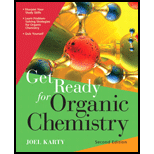
(a)
Interpretation:
For each given reaction, the structure of each product is to be drawn.
Concept introduction:
If the reactant molecule has two different functional groups attached to different places on the same molecule, then intramolecular reaction is possible. Whenever an intramolecular reaction can take place, an intermolecular reaction is also possible. When a five or six-membered ring can be formed, the intramolecular cyclization reactions are favored over their corresponding intermolecular reactions.
(b)
Interpretation:
For the given reaction, the mechanism that accounts for the formation of each of those products is to be drawn.
Concept introduction:
If the reactant molecule has two different functional groups attached to different places on the same molecule, then the intramolecular reaction is possible. Whenever an intramolecular reaction can take place, an intermolecular reaction is also possible. When a five or six-membered ring can be formed, the intramolecular cyclization reactions are favored over their corresponding intermolecular reactions.
(c)
Interpretation:
How the isomeric reactants lead to different products is to be explained.
Concept introduction:
If the reactant molecule has two different functional groups attached to different places on the same molecule, then the intramolecular reaction is possible. Whenever an intramolecular reaction can take place, an intermolecular reaction is also possible. When a five or six-membered ring can be formed, the intramolecular cyclization reactions are favored over their corresponding intermolecular reactions.
Want to see the full answer?
Check out a sample textbook solution
Chapter 9 Solutions
Get Ready for Organic Chemistry
- The reaction shown here yields three different nucleophilic substitution products that are constitutional isomers of one another. (a) Does this suggest an SN1 or Sn2 mechanism? (b) Draw the mechanism for the formation of each of these products. CH3CH2OH Brarrow_forwardThe enamine prepared from acetone and dimethylamine is shown here in its lowest-energy form. (a) What is the geometry and hybridization of the nitrogen atom? (b) What orbital on nitrogen holds the lone pair of electrons? (c) What is the geometric relationship between the p orbitals of the double bond and the nitrogen orbital that holds the lone pair? Why do you think this geometry represents the minimum energy?arrow_forwardDraw an energy diagram for each reaction in Problem 20.28, paying attention to the relative energies of the overall reactants, overall products, and any intermediates.arrow_forward
- Which reaction in each of the following pairs would you expect to be faster? (i) Write both reactions using bond-line presentation and, using arrows providing a mechanistic explanation of the course of the reaction, draw either a transition state or an intermediate product of the reaction; (ii) Shortly (one sentence) explain your reasoning why one of the two reactions will be faster.arrow_forwardHydroxylamine, H2NOH, has both an OH functional group and an NH2 functional group, so it can feasibly undergo reaction with a ketone or an aldehyde to produce either an acetal or an imine-like compound called an oxime. (a) Draw each of these mechanisms for the reaction of hydroxylamine with acetone. (b) Which is the major product? Hint: Which step decides the outcome?arrow_forwardWhen ethylbenzene reacts with bromine in a free radical halogenation, a small amount ofproduct that contains no bromine is formed. Show the mechanism of how the product isformed and the product. Explain why only a small amount of that product is formed.arrow_forward
- The reaction is a nucleophilic substitution, A is OH- and B is an alkyl bromide. Give the reaction mechanism and explain your reasoning.arrow_forwardGive detailed Solution with explanation neededarrow_forwardDraw the curved arrows and the product for each of the following nucleophilic addition steps. (a) (b) + CH,OK ? + CH3LI (c) MgBr (d) ? + NABH4 ? (e) (f) O → ? ? + N2OH +arrow_forward
- Gg.108.arrow_forward(a) Provide the structures of two possible organic products. (b) Circle the major organic product. NBS hvarrow_forwardPlease provide a complete, detailed curved-arrow mechanism for the following reaction.Include ALL lone pairs and formal charges. Using the mechanism and a few words,explain the why the NaH deprotonates at the selected a-position and not the other a-position. Also explain why the indicated alkene is formed in the 3rd step rather than the other possible alkene product.arrow_forward
 ChemistryChemistryISBN:9781305957404Author:Steven S. Zumdahl, Susan A. Zumdahl, Donald J. DeCostePublisher:Cengage Learning
ChemistryChemistryISBN:9781305957404Author:Steven S. Zumdahl, Susan A. Zumdahl, Donald J. DeCostePublisher:Cengage Learning ChemistryChemistryISBN:9781259911156Author:Raymond Chang Dr., Jason Overby ProfessorPublisher:McGraw-Hill Education
ChemistryChemistryISBN:9781259911156Author:Raymond Chang Dr., Jason Overby ProfessorPublisher:McGraw-Hill Education Principles of Instrumental AnalysisChemistryISBN:9781305577213Author:Douglas A. Skoog, F. James Holler, Stanley R. CrouchPublisher:Cengage Learning
Principles of Instrumental AnalysisChemistryISBN:9781305577213Author:Douglas A. Skoog, F. James Holler, Stanley R. CrouchPublisher:Cengage Learning Organic ChemistryChemistryISBN:9780078021558Author:Janice Gorzynski Smith Dr.Publisher:McGraw-Hill Education
Organic ChemistryChemistryISBN:9780078021558Author:Janice Gorzynski Smith Dr.Publisher:McGraw-Hill Education Chemistry: Principles and ReactionsChemistryISBN:9781305079373Author:William L. Masterton, Cecile N. HurleyPublisher:Cengage Learning
Chemistry: Principles and ReactionsChemistryISBN:9781305079373Author:William L. Masterton, Cecile N. HurleyPublisher:Cengage Learning Elementary Principles of Chemical Processes, Bind...ChemistryISBN:9781118431221Author:Richard M. Felder, Ronald W. Rousseau, Lisa G. BullardPublisher:WILEY
Elementary Principles of Chemical Processes, Bind...ChemistryISBN:9781118431221Author:Richard M. Felder, Ronald W. Rousseau, Lisa G. BullardPublisher:WILEY





